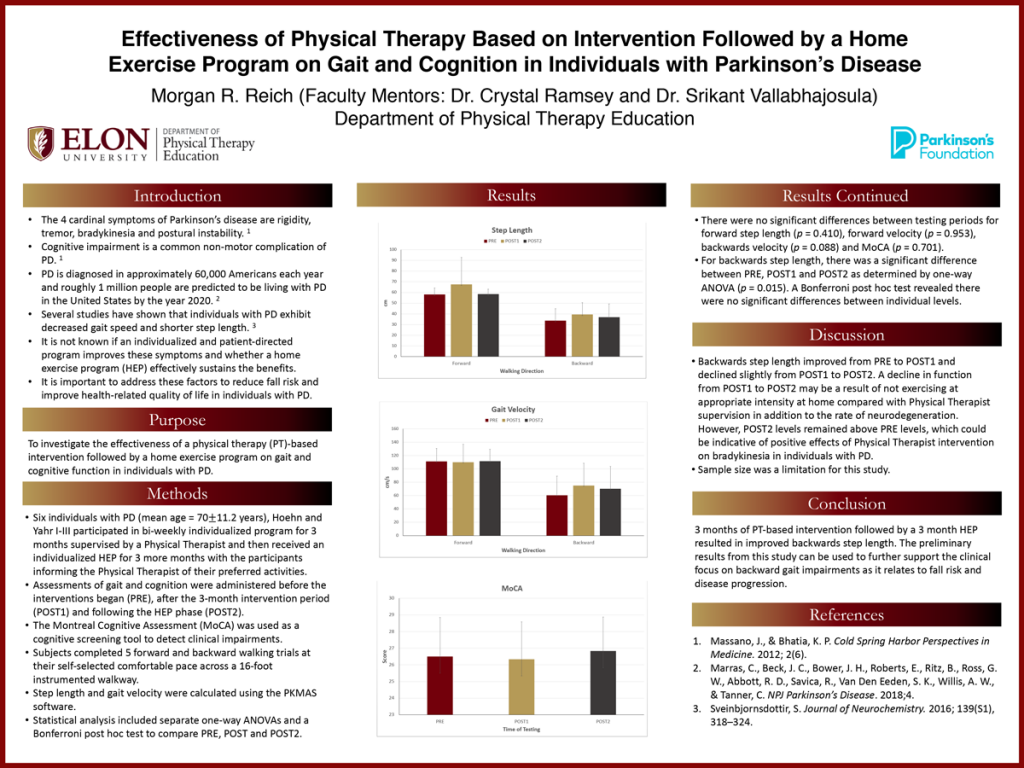Morgan Reich
Class of 2020
- Biology

Effectiveness of Physical Therapy Based on Intervention Followed by a Home Exercise Program on Gait and Cognition in Individuals with Parkinson’s Disease
Project Mentors:
- Crystal Ramsey, assistant professor of physical therapy education
- Srikant Vallabhajosula, associate professor of physical therapy education
Project Abstract
Parkinson’s disease (PD) is a progressive neurological disorder characterized by rigidity, tremor, bradykinesia, balance deficits and cognitive impairments. Several studies have shown that individuals with PD exhibit decreased gait speed and shorter step length. However, it is not known if an individualized and patient-directed program improves these symptoms and whether a home exercise program (HEP) effectively sustains the benefits. It is important to address these factors to reduce fall risk and improve health-related quality of life in individuals with PD. Purpose: To investigate the effectiveness of a physical therapist (PT)-guided intervention followed by a HEP on gait and cognitive function in individuals with PD. Methods: Six participants with PD (Hoehn and Yahr I-III) participated in bi-weekly individualized program for 3 months supervised by a PT and then received an individualized HEP for 3 more months with the participants informing the PT of their preferred activities. Assessments of gait and cognition were administered before the interventions began (pre), after the 3-month intervention period (post) and following the HEP phase (post2). The Montreal Cognitive Assessment (MoCA) was used as a cognitive screening tool to detect clinical impairments. Subjects completed 5 forward and backward walking trials across a 16-foot instrumented walkway. Step length and gait speed were calculated. Results: Step length for pre, post and post2 forward walking averaged 58.11±6.09-cm, 67.56±25.22-cm and 58.53±4.54-cm respectively. Gait velocity for pre, post, and post2 forward walking averaged 1.11±0.19-m/s, 1.09±0.27-m/s, and 1.11±0.18-m/s respectively. Step length for pre, post and post2 backward walking averaged 33.58±11.25-cm, 39.35 ±11.11-cm, and 36.97±12.3-cm respectively. Gait speed for pre, post and post2 backward walking averaged 0.60±0.29-m/s, 0.75±0.33-m/s and 0.70±0.33-m/s respectively. Pre, post and post2 MoCA scores averaged 26.50±2.35, 26.17±2.23, and 26.83±2.04 respectively. Conclusion: The majority of measures increased from pre to post and decreased from post to post2. It is possible not exercising at appropriate intensity at home compared with PT supervision and the rate of neurodegeneration led to this decline in function during post2. The preliminary results from this study can be used to further support the clinical focus on backward gait impairments as it relates to fall risk and disease progression.
 Download Project Presentation
Download Project Presentation